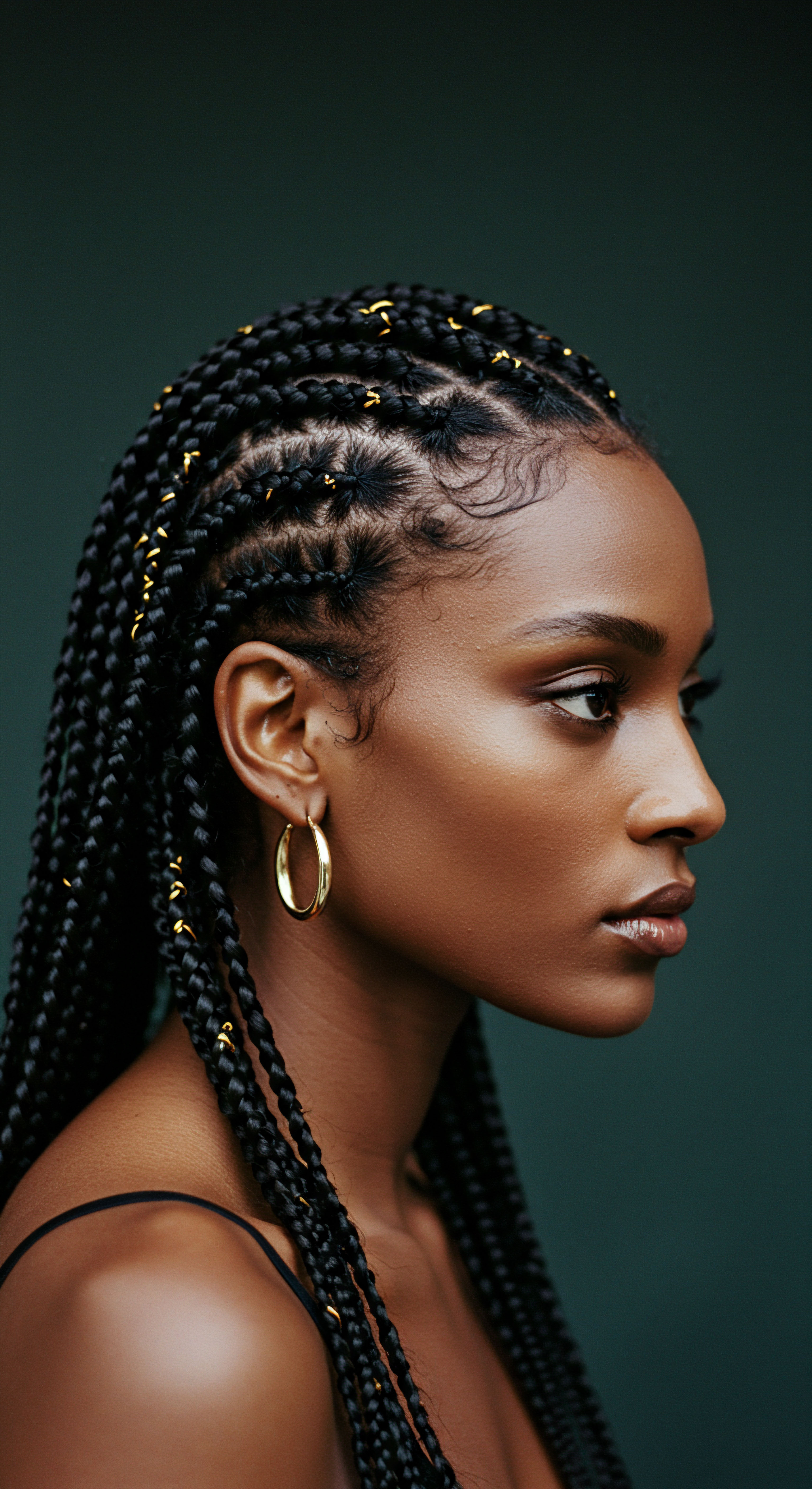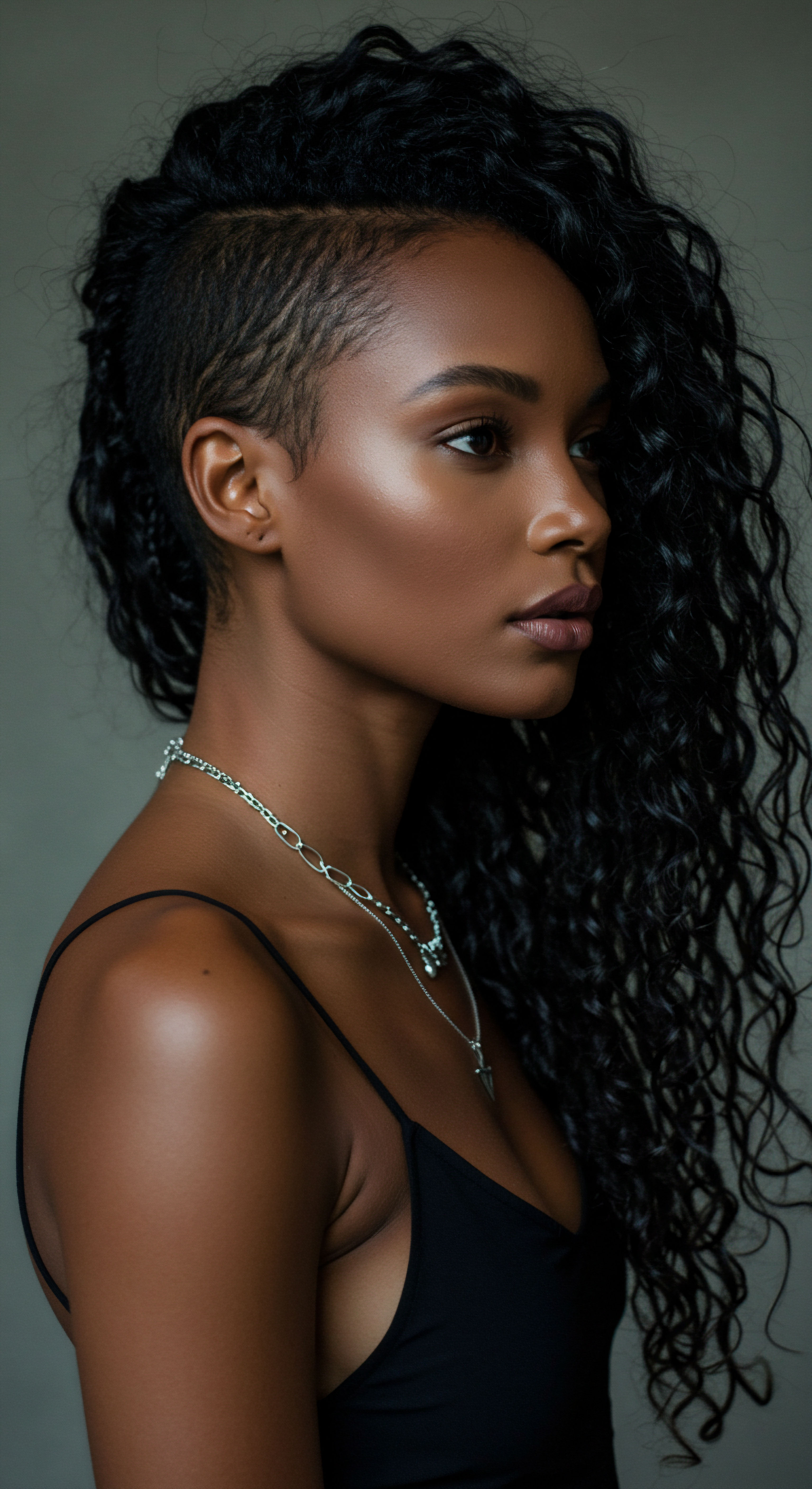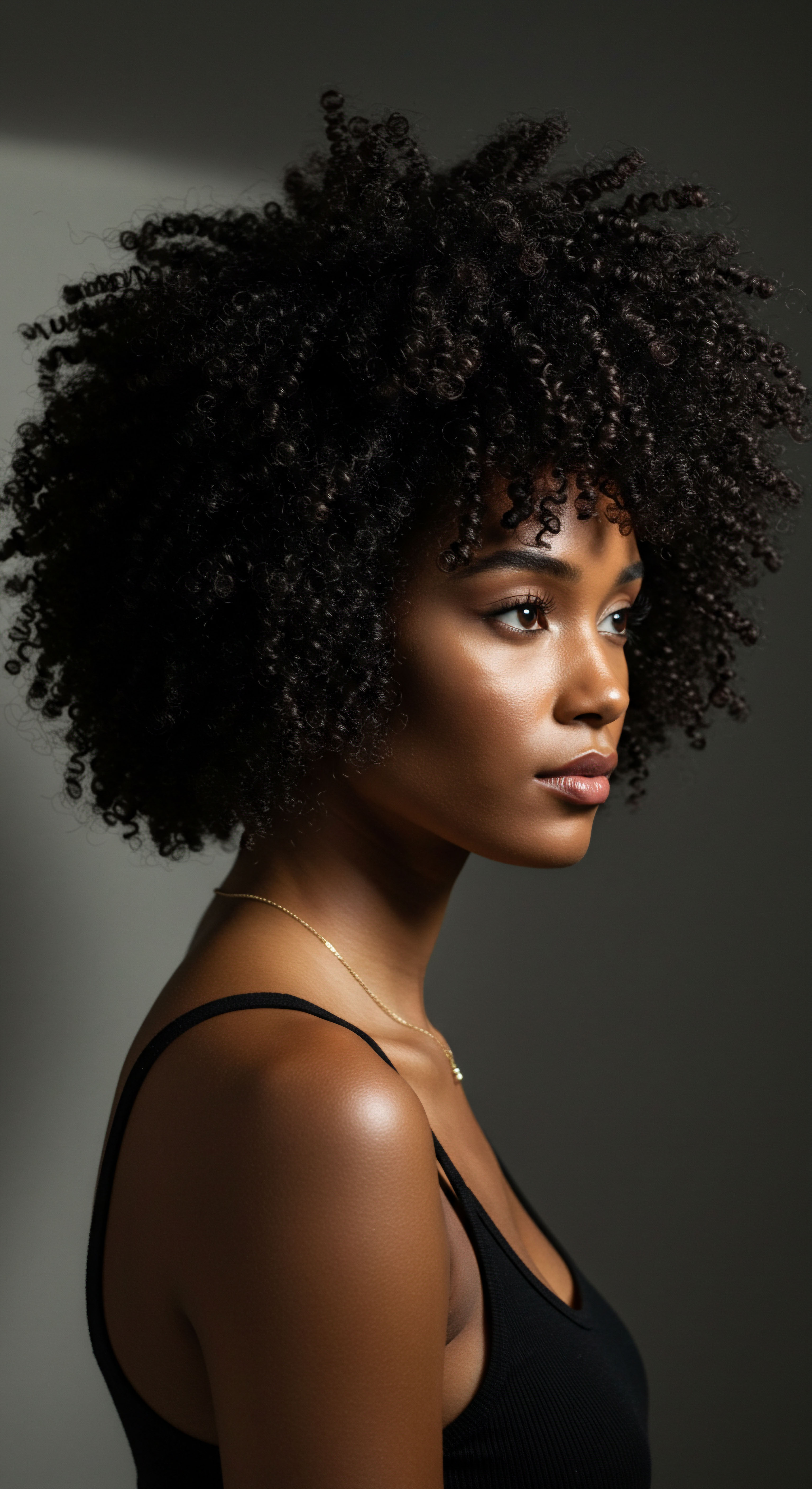
Roots
There exists a quiet language whispered by our strands, a conversation held nightly between the delicate architecture of textured hair and the world it rests upon. For many, the hours of slumber are not merely a pause in the day’s activity but a profound, often overlooked, period of interaction that shapes the vitality and integrity of curls, coils, and waves. To truly appreciate the necessity of thoughtful sleep rituals for textured hair, one must first look to the very essence of what these unique strands are and how they respond to their environment. It calls for an understanding that extends beyond the superficial, reaching into the microscopic realm where each fiber tells a story of resilience and vulnerability.
The distinctive geometry of textured hair, whether it forms tight coils, springy curls, or undulating waves, renders it inherently more prone to certain mechanical challenges. Unlike straight hair, which tends to have a more uniform, cylindrical shape, textured strands exhibit an elliptical cross-section. This unique contour creates natural points of weakness along the hair shaft where the cuticle, the outermost protective layer, lifts and separates more readily. As these strands intersect and interlock, particularly during movement, they create friction points that can lead to abrasion and, over time, significant structural compromise.
The distinct geometry of textured hair makes it uniquely susceptible to friction and mechanical wear during rest.

Anatomy of Textured Hair
To comprehend why sleep rituals are so vital, we begin with the fundamental components of a single hair strand. Each fiber emerges from a follicle, a tiny organ nestled within the scalp. The shape of this follicle largely dictates the curl pattern of the hair that grows from it. For highly textured hair, the follicle often has an elliptical or even ribbon-like opening, causing the hair to spiral as it grows.
This spiraling path means that the hair cuticle, composed of overlapping scales much like roof shingles, does not lie as flat as it would on a straight strand. These slightly raised scales, while protective, can snag on external surfaces or even on neighboring strands.
Beneath the cuticle lies the cortex, the primary bulk of the hair, consisting of keratin proteins that provide strength and elasticity. The distribution of these proteins, along with the presence of disulfide bonds, influences the hair’s ability to stretch and return to its original shape. For textured hair, the cortex can vary in density along the curl pattern, further contributing to areas of differing strength. The innermost layer, the medulla, may or may not be present and its role in hair health is still being fully understood, though it is thought to contribute to the hair’s overall resilience.

How Hair Growth Cycles Influence Care
Hair growth follows a cyclical pattern, moving through phases of growth (anagen), transition (catagen), and rest (telogen), before shedding (exogen). Understanding these cycles offers insight into why consistent care, even during sleep, is so significant. During the active anagen phase, which can last for several years for scalp hair, strands are actively growing and at their most robust. However, as hair ages and progresses through its cycle, it becomes more vulnerable to damage.
Older hair, particularly at the ends, has endured more environmental stressors, styling manipulations, and friction. This accumulated wear means that the hair is increasingly susceptible to breakage, making nighttime protection a preventative measure against accelerated degradation of these older, more fragile segments.
Considering the continuous nature of hair growth, each new strand emerging from the scalp will eventually face the same challenges. Establishing gentle sleep practices early in the hair’s life cycle can help preserve its integrity from the very beginning, ensuring that each new length has the best possible chance to thrive. This proactive approach supports not just the appearance of the hair, but its underlying health and structural longevity.
- Hair Follicle Shape ❉ Determines the curl pattern and contributes to cuticle lifting.
- Cuticle Layer ❉ Overlapping scales that protect the hair, but can snag when raised.
- Cortex Structure ❉ Keratin proteins providing strength, with varying density along textured strands.
| Hair Layer Cuticle |
| Composition Overlapping keratinized scales |
| Primary Role Outer protective barrier, regulates moisture |
| Hair Layer Cortex |
| Composition Keratin protein fibers, disulfide bonds |
| Primary Role Strength, elasticity, color pigment |
| Hair Layer Medulla |
| Composition Innermost core (not always present) |
| Primary Role Thought to influence hair properties, but less understood |
| Hair Layer Each layer plays a part in the overall health and resilience of textured hair. |

Ritual
As daylight fades and the world quiets, a unique opportunity presents itself for those with textured hair ❉ the chance to transform unconscious slumber into a period of intentional care. The transition from day to night is not merely a change in lighting; it is a shift in the hair’s environmental interactions, and with it, a need for deliberate actions. Moving beyond the foundational understanding of hair structure, we now consider the practical wisdom of sleep rituals—the gentle, purposeful acts that safeguard textured strands through the night. These are not burdensome tasks, but rather a serene conclusion to the day, designed to preserve the hair’s moisture, reduce mechanical stress, and maintain styling efforts.
The significance of these rituals lies in their ability to counteract the subtle yet constant forces that work against hair health during sleep. The tossing and turning, the pressure against pillowcases, and the potential for moisture loss in the air all contribute to friction and dehydration. By proactively addressing these factors, sleep rituals become a quiet guardian, allowing the hair to rest and rejuvenate rather than suffer silent damage.

What Are Common Nighttime Hair Hazards?
Nighttime presents several distinct challenges for textured hair. One primary concern involves the physical interaction between hair and bedding. Cotton pillowcases, ubiquitous in many homes, possess a coarse fiber structure that creates significant friction against delicate hair cuticles.
As one shifts during sleep, this friction can cause the cuticle scales to lift, leading to roughness, frizz, and ultimately, breakage. This mechanical abrasion is a silent aggressor, slowly eroding the hair’s outer defense.
Another hazard is moisture loss. Hair, especially textured hair, thrives on moisture. The ambient air, particularly in heated or air-conditioned environments, can draw hydration from the strands. Cotton, being a highly absorbent material, can also wick away natural oils and applied products from the hair, leaving it dry and brittle by morning.
This dehydration compromises the hair’s elasticity, making it more susceptible to damage from even minor manipulation. The combined effect of friction and moisture depletion creates a cycle of vulnerability that daily styling alone struggles to overcome.

How Do Protective Styles Aid Sleep Preservation?
Protective styling for sleep serves as a crucial line of defense. These styles aim to minimize tangling, reduce exposure to friction, and keep the hair neatly contained. Simple braids, twists, or a loose bun positioned at the crown of the head can dramatically reduce the surface area of hair rubbing against the pillow. This containment also helps to maintain the integrity of existing styles, meaning less need for re-styling and manipulation in the morning, which in turn reduces overall wear and tear.
For instance, a loose pineapple bun, where hair is gathered high on the head, keeps the majority of the hair off the neck and pillow, preserving curl definition and reducing frizz. Two-strand twists or braids, on the other hand, stretch the hair slightly and keep it elongated, preventing shrinkage and tangles overnight. The choice of protective style often depends on the hair’s length, texture, and the desired look for the following day, but the underlying principle remains constant ❉ minimize direct contact and maintain hair alignment.
Protective styles for sleep act as a vital shield, minimizing tangles and reducing friction against bedding.
The deliberate choice of sleep accessories also plays a significant role. Silk or satin pillowcases, with their smooth surfaces, allow hair to glide rather than snag. This dramatically reduces friction, preserving the cuticle and preventing frizz.
Bonnets and scarves, made from similar smooth materials, offer an additional layer of protection, completely encasing the hair and creating a controlled micro-environment that helps retain moisture. These accessories are not mere adornments; they are functional tools that contribute directly to the health and appearance of textured hair.
- Smooth Surfaces ❉ Silk or satin pillowcases allow hair to glide, minimizing friction.
- Hair Containment ❉ Bonnets and scarves protect hair from environmental stressors and rubbing.
- Moisture Retention ❉ Non-absorbent materials help hair retain its natural hydration and applied products.
| Material Cotton |
| Surface Texture Rough, fibrous |
| Moisture Absorption High |
| Friction Level High |
| Material Silk |
| Surface Texture Smooth, fine |
| Moisture Absorption Low |
| Friction Level Very Low |
| Material Satin |
| Surface Texture Smooth, synthetic |
| Moisture Absorption Low |
| Friction Level Low |
| Material Selecting smooth, non-absorbent materials can significantly improve hair health. |

Relay
Beyond the tactile benefits and immediate aesthetic gains, the deeper implications of textured hair sleep rituals extend into realms of science, psychology, and cultural continuity. This is where the quiet practice of wrapping hair before bed transforms from a simple act into a complex interplay of biological preservation, mental well-being, and a silent acknowledgement of heritage. To truly grasp why these nightly practices hold such weight, we must consider the intricate connections that bind hair health to our broader human experience, looking beyond the visible to the data and the deeply rooted traditions.
The very act of preparing textured hair for sleep is a testament to its unique biomechanical properties. The coiled and curved structure, while beautiful, renders these strands particularly susceptible to mechanical stress. Research consistently demonstrates that the more tightly coiled a hair strand, the more fragile it becomes at its curves and bends. This inherent fragility makes minimizing external forces during sleep not merely advisable, but a biological imperative for maintaining structural integrity.

What Does Science Say About Nighttime Hair Damage?
Scientific investigations into hair damage often focus on external stressors, and sleep friction stands as a significant, yet often underestimated, contributor. A study published in the Journal of Cosmetic Science (2018) titled “Impact of Textile Surface on Hair Breakage and Frizz for African Hair” by L. R. C.
M. L. F. P.
A. A. B. C.
offers compelling quantitative evidence. Researchers analyzed the friction coefficient and tensile properties of African hair on various textile surfaces, including cotton, silk, and satin. The findings indicated that cotton fabrics exhibited significantly higher friction coefficients compared to silk and satin, leading to greater mechanical stress on the hair fibers. Specifically, the study reported that hair samples exposed to cotton surfaces showed a Higher Incidence of Cuticle Lifting and Fracture compared to those exposed to silk or satin, directly correlating textile choice with microscopic hair damage. This data moves beyond anecdotal preference, grounding the choice of sleep surface in empirical observation of hair integrity at a cellular level.
This microscopic damage, accumulated nightly, contributes to a gradual degradation of the hair shaft. Over time, repeated friction causes the cuticle scales to chip away, exposing the inner cortex to environmental elements and leading to increased porosity. Porous hair struggles to retain moisture, creating a cycle of dryness, brittleness, and further breakage. The seemingly simple act of sleeping on a specific fabric therefore holds a direct, measurable impact on the long-term health and appearance of textured hair.

How Do Sleep Rituals Influence Hair Hydration?
The preservation of moisture is a critical aspect of textured hair care, and nighttime rituals play a central role. Unlike straight hair, the coiled structure of textured hair makes it more difficult for natural oils produced by the scalp to travel down the entire length of the strand. This anatomical reality often results in textured hair being naturally drier. When combined with the dehydrating effects of ambient air and absorbent bedding materials, the hair’s moisture levels can plummet overnight.
Using protective head coverings such as silk or satin bonnets, or sleeping on silk pillowcases, creates a localized microclimate around the hair. These materials are non-absorbent, meaning they do not wick away the hair’s natural sebum or any applied moisturizers and conditioners. By retaining this vital hydration, the hair remains pliable and elastic, significantly reducing the likelihood of breakage from manipulation or friction. This consistent overnight moisture preservation contributes to overall hair health, elasticity, and shine, creating a favorable environment for growth and reducing the appearance of dryness and dullness.
Consistent overnight moisture preservation fosters hair health, elasticity, and shine.

What Are the Psychological and Cultural Dimensions?
Beyond the scientific and practical, textured hair sleep rituals carry profound psychological and cultural weight. For many individuals with textured hair, particularly those of African descent, hair is not merely an aesthetic feature; it is a powerful symbol of identity, heritage, and resilience. The care of textured hair has historically been intertwined with cultural practices, often passed down through generations. These nightly rituals become a continuation of that legacy, a quiet act of self-care that connects one to ancestral wisdom and a collective identity.
The deliberate act of protecting one’s hair before sleep can also serve as a moment of mindfulness and self-connection. In a world that often pressures conformity, tending to one’s unique hair texture can be an act of quiet rebellion and self-acceptance. It cultivates a deeper appreciation for the hair’s natural state and fosters a sense of personal agency over one’s appearance and well-being. This daily commitment to care can contribute to a positive self-perception and reduce the stress associated with hair management, transforming a routine into a grounding personal ceremony.
The cultural significance of hair protection, especially during vulnerable states like sleep, is deeply embedded in various traditions. These practices speak to a long-standing understanding of hair as a delicate and sacred part of the body, deserving of special attention and preservation.
- Historical Context ❉ Many African and diasporic cultures have long traditions of hair wrapping and protection, often linked to spiritual beliefs, social status, and preservation of beauty.
- Identity Formation ❉ For individuals, the daily care of textured hair can be a tangible connection to their cultural background and a celebration of their unique identity.
- Self-Care Practice ❉ The ritual provides a consistent opportunity for self-nurturing, fostering a positive relationship with one’s hair and overall well-being.
| Attribute Frizz |
| Without Rituals Increased due to friction and cuticle lifting |
| With Consistent Rituals Reduced due to smooth surfaces and protection |
| Attribute Breakage |
| Without Rituals Higher incidence from mechanical stress and dehydration |
| With Consistent Rituals Lower incidence, hair remains stronger |
| Attribute Moisture Level |
| Without Rituals Decreased, leading to dryness and brittleness |
| With Consistent Rituals Maintained, promoting elasticity and softness |
| Attribute Definition |
| Without Rituals Lost overnight, requiring more morning manipulation |
| With Consistent Rituals Preserved, requiring less restyling |
| Attribute Consistent sleep rituals contribute significantly to the long-term health and aesthetic of textured hair. |

Reflection
The journey through the nuanced world of textured hair sleep rituals reveals far more than mere beauty tips; it uncovers a tapestry of science, self-care, and deep cultural resonance. These nightly acts, seemingly simple, are in fact profound declarations of respect for the intricate biology of textured strands and a quiet acknowledgment of the heritage they carry. To truly appreciate their value is to see beyond the superficial sheen of a well-kept curl and recognize the deep commitment to preservation, identity, and well-being that unfolds each night. The wisdom of protecting textured hair during slumber is a timeless practice, echoing through generations, continually reminding us that true care is often found in the gentle, consistent efforts made in the quiet hours.

References
- L. R. C. M. L. F. P. A. A. B. C. (2018). Impact of Textile Surface on Hair Breakage and Frizz for African Hair. Journal of Cosmetic Science, 69(1), 1-10.
- Robbins, C. R. (2012). Chemical and Physical Behavior of Human Hair. Springer Science & Business Media.
- Swift, J. A. (2007). The Science of Hair. Royal Society of Chemistry.
- Dawber, R. P. R. (2001). Hair and Scalp Disorders ❉ Common Problems and Their Management. CRC Press.
- Bouillon, C. E. & Wilkinson, J. B. (2005). The Science of Hair Care. CRC Press.
- Garnier, M. (1998). Hair and Hair Diseases. Springer.
- Van Scott, E. J. & Yu, R. J. (2001). Alpha Hydroxy Acids in Cosmetic Dermatology. CRC Press.
- Khumalo, N. P. (2005). Traction Alopecia ❉ The South African Experience. International Journal of Dermatology, 44(S1), 50-52.